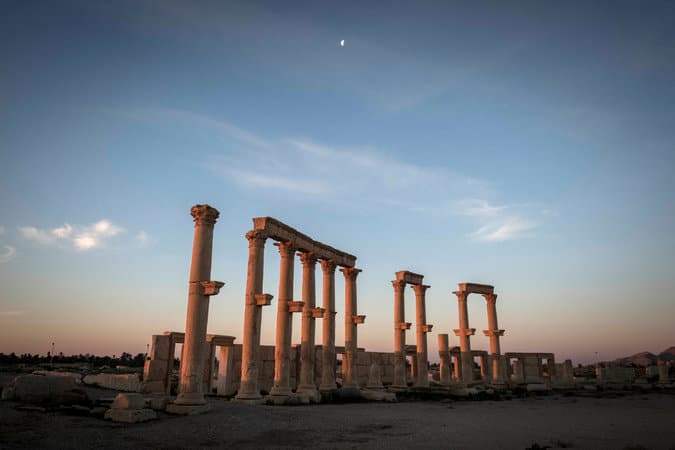
The site of Palmyra, in Syria, connects modern visitors to the Roman Empire. Credit Sergey Ponomarev for The New York Times
THE guard from the antiquities authority was asleep when I arrived at the Temple of Bel, deep in the Syrian desert. Not unreasonable, given that it was before visiting hours, maybe 5:30 a.m., and almost totally dark. A ribbon of purple on the horizon hinted at sunrise, and the war raging over there, in Iraq. But this was Syria, in 2005, and another day of the Assad family dictatorship was dawning in perfect order. European tourists were about to crawl over the ruins of Palmyra, and the biggest structure of all, a 2,000-year-old monument to an official god, was barely visible in front of me. “O.K.,” the guard said, waving me inside. “Go ahead. You can look.”
People who dream of time travel haven’t been to enough archaeological sites. Palmyra’s old stones have traversed 2,000 years to reach us. Running my fingertips over the soot-stained niches and fallen capitals inside the temple that morning, I was touching not history, not the past, but the present and its origins at the same time. Old stones make time travel possible. Now Rome and the Islamic State, or ISIS, will meet.
Islamic State militants rolled out of the desert last week, taking the town of Palmyra, also known as Tadmur, with 50,000 residents — and overrunning the ruins. Both the old stones and the people are priceless, and we have some idea what the Islamic State intends to do with both. At archaeological sites like Hatra and Nimrud, the Islamic State has already dynamited even older ruins. They were willing to gamble reinforcements and take serious casualties in order to destroy these stones, which they view as idols to false gods.
Ancient Palmyra was an oasis town that looked outward to caravans, but eventually the Romans took over, creating an improbably vast settlement whose colonnaded lanes and arched entrances were built for Caesars. The ruins cover roughly three square miles of open desert, and still offer — at least for now — a time capsule from the height of their empire. I spent the rest of that morning a decade ago crawling through a local senate building, and a bathhouse labeled Frigidarium. The great theater of the city, still in exquisite preservation, had seven stage entrances, a daring departure from Roman convention about the exits and entrances of gods and heroes.
The Romans marched this far into the hostile desert because Palmyra was a crucial nexus on the Silk Road, a trading post where Arab caravans disgorged their precious cargoes from the east. Roman businessmen, followed by colonists and armies, turned this dot in the desert into a kind of dry Venice, a hub of exchange that enriched everyone involved. In Roman fashion, the conquerors absorbed the local deity known as Bel, building that immense cathedral to co-opt his followers.
For a brief few centuries, their empire reached toward Central Asia here, with diplomats, traders and map makers all looking eastward from Palmyra, the farthest fringe of their own world.
THE idea that we can “save” ruins is both sublime and ridiculous. Before Machu Picchu was restored or Angkor Wat cleaned up, European archaeologists of the 19th century reportedly propped up the scores of columns that had fallen over in Palmyra, adding stones as needed, effectively faking the site’s landmark vista. It’s also hard to rescue a lump of broken stone, and Palmyra is mostly rubble. A Roman emperor did much of the damage, brutally sacking the oasis to end a rebellion. Palmyra’s grandeur came pre-shattered.
It is their age that makes these stones worth knowing, not their condition. Decay and loss is the point. If ISIS knocks down the columns, or dynamites the carved lion’s head I found lying around that day, the disaster will be survivable. It’s also worth remembering that these gestures of iconic destruction backfire. In Afghanistan the Taliban destroyed two huge statues of Buddha in 2001, and now those piles of rubble are known around the world. I’ll take some consolation knowing the site has been explored and recorded by waves of archaeologists for more than a century. We know Palmyra’s secrets, and cannot lose them.
It is of course a loss: With each lost site, we lose the power of witness, the precious chance to close the circuit between ourselves and the past. We need archaeological sites to give us solidarity with humans beyond our own moment.
No part of Syria is without such interwoven layers of ruins, and today’s artillery-ruined cities are merely the latest stratum to accumulate on top. One archaeological record could begin with decayed French colonial sites, like the dusty hotel in Latakia where I saw Lawrence of Arabia’s bill for “limonato” framed on the wall. Below that was the Ottoman deposit — buildings like the great damascene bathhouse of Aleppo, where, in the presence of centuries of history, for $5 I was steamed, scrubbed and massaged by teams of men, then handed a robe and an orange soda.
But even in Syria — arguably the greatest archaeological zone in the world — Palmyra was exceptional for its scale and classical perfection. A chance encounter with a Dutch archaeologist on my morning at the site reminded me why: She was racing from one mound of old rocks to another, measuring, and complained to me that the Syrian government had given her only three months to complete her Ph.D. survey. “It’s not enough time,” she said, in a place that always seemed to have more time.
Looking for shade, I walked at one point to the edge of the ruins, where I sheltered in a tall Roman hall, one of the few still holding a roof. This proved to be a temple where Roman legions stored their pennants and eagles between campaigns. The dark walls held inscriptions beyond my rudimentary Latin. It was impossible not to be moved by the actuality of it; there I was, on the very stones where ancient armies rested. Intricate terra-cotta patterns were laid overhead, each bit of mud frozen into shape by human hands thousands of years ago. If dynamite takes away the stone pillars of great men, we should mourn the fingerprints on mud-work just as much as the pillars.
In the course of its destructive rise, the Islamic State has attacked archaeological sites with gusto, targeting the ancient Assyrian capital of Khorsabad in March. In February, militia men even filmed themselves attacking statues in the Mosul Museum with sledgehammers.
The lost antiquities are not always quite as destroyed as jihadists claim. The Islamic State neglected to mention in its video that it may actually be selling, not smashing, most of the Mosul Museum collection. If looting ever had a moral moment, this is it. The Druse leader Walid Jumblatt once proudly showed me his collection of Roman antiquities from around Lebanon, which included nearly perfect mosaic floors pulled from old villas, and the sarcophagus of a Roman ship captain. When I asked how he had gotten them, he told me he paid cash during the war. He’d kept the sarcophagus — it guards his front door, along with bomb-sniffing dogs — but opened a museum for the mosaics. It was the only time I’ve ever wanted to hug an ex-warlord.
There has been talk of military intervention to save places like Palmyra. We should save the people first. Stones will be pulled down, and put back up, and still testify to the same idea, trade and contact between different worlds. That instinct predates the columns and the bragging piety of the businessmen who paid for statues of themselves with profits from Chinese silk. Palmyra is precious and irreplaceable, but the drive that created it — the human need to reach outward, to others, for glory, for wealth, for knowledge — will survive long after both the stones and the Islamic State are gone.
Patrick Symmes is is a contributing editor at Outside magazine and the author of “Chasing Che: A Motorcycle Journey in Search of the Guevara Legend.”
A version of this op-ed appears in print on May 24, 2015, on page SR7 of the New York edition with the headline: The Ancient Ruins Terror Can’t Destroy.
Source: The Ancient Ruins Terror Can’t Destroy – NYTimes.com



